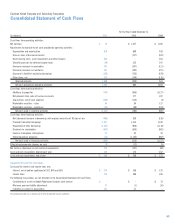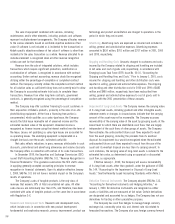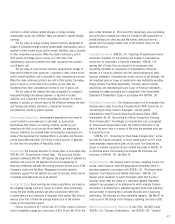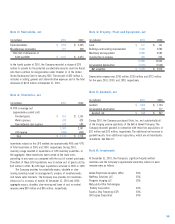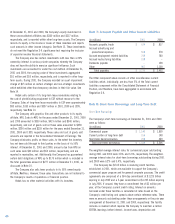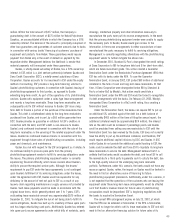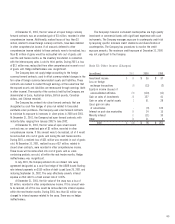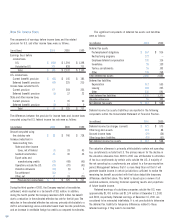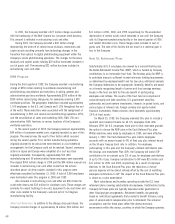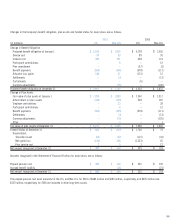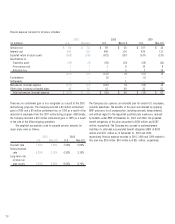Kodak 2001 Annual Report Download - page 65
Download and view the complete annual report
Please find page 65 of the 2001 Kodak annual report below. You can navigate through the pages in the report by either clicking on the pages listed below, or by using the keyword search tool below to find specific information within the annual report.
million. Within the total amount of $277 million, the Company is
guaranteeing debt in the amount of $175 million for Kodak Polychrome
Graphics, an unconsolidated affiliate in which the Company has a 50%
ownership interest. The balance of the amount is principally comprised of
other loan guarantees and guarantees of customer amounts due to banks
in connection with various banks’ financing of customers’ purchase of
equipment and products from Kodak. These guarantees would require
payment from Kodak only in the event of default on payment by the
respective debtor. Management believes the likelihood is remote that
material payments will be required under these guarantees.
Qualex, a wholly-owned subsidiary of Kodak, has a 50% ownership
interest in ESF, which is a joint venture partnership between Qualex and
Dana Credit Corporation (DCC), a wholly-owned subsidiary of Dana
Corporation. Qualex accounts for its investment in ESF under the equity
method of accounting. ESF provides a long-term financing solution to
Qualex’s photofinishing customers in connection with Qualex’s leasing of
photofinishing equipment to third parties, as opposed to Qualex
extending long-term credit. As part of the operations of its photofinishing
services, Qualex sells equipment under a sales-type lease arrangement
and records a long-term receivable. These long-term receivables are
subsequently sold to ESF without recourse to Qualex. ESF incurs long-
term debt to finance a portion of the purchase of the receivables from
Qualex. This debt is collateralized solely by the long-term receivables
purchased from Qualex, and in part, by a $60 million guarantee from
DCC. Qualex provides no guarantee or collateral to ESF’s creditors in
connection with the debt, and ESF’s debt is non-recourse to Qualex.
Qualex’s only continued involvement in connection with the sale of the
long-term receivables is the servicing of the related equipment under the
leases. Qualex has continued revenue streams in connection with this
equipment through future sales of photofinishing consumables, including
paper and chemicals, and maintenance.
Qualex has risk with respect to the ESF arrangement as it relates to
its continued ability to procure spare parts from the primary
photofinishing equipment vendor to fulfill its servicing obligations under
the leases. The primary photofinishing equipment vendor is currently
experiencing financial difficulty, which raises concern about Qualex’s
ability to procure the required service parts. Although the lessees’
requirement to pay ESF under the lease agreements is not contingent
upon Qualex’s fulfillment of its servicing obligations under the leases,
under the agreement with ESF, Qualex would be responsible for any
deficiency in the amount of rent not paid to ESF as a result of any
lessee’s claim regarding maintenance or supply services not provided by
Qualex. Such lease payments would be made in accordance with the
original lease terms, which generally extend over 5 to 7 years. ESF’s
outstanding lease receivable amount was approximately $570 million at
December 31, 2001. To mitigate the risk of not being able to fulfill its
service obligations, Qualex has built up its inventory of these spare parts
and has begun refurbishing used parts. Additionally, Qualex has entered
into spare parts escrow agreements under which bills of materials, parts
drawings, intellectual property and other information necessary to
manufacture the parts were put into escrow arrangements. In the event
that the primary photofinishing equipment vendor were unable to supply
the necessary parts to Qualex, Qualex would gain access to the
information in the escrow arrangements to either manufacture or have
manufactured the parts necessary to fulfill its servicing obligations.
Management is currently negotiating alternatives with the photofinishing
equipment vendor to further mitigate the above risks.
In December 2001, Standard & Poor’s downgraded the credit ratings
of Dana Corporation to BB for long-term debt and B for short-term debt,
which are below investment grade. This action created a Guarantor
Termination Event under the Receivables Purchase Agreement (RPA) that
ESF has with its banks under the RPA. To cure the Guarantor
Termination Event, in January 2002, ESF posted $60 million of additional
collateral in the form of cash and long-term lease receivables. At that
time, if Dana Corporation were downgraded below BB by Standard &
Poor’s or below Ba2 by Moody’s, that action would constitute a
Termination Event under the RPA and ESF would be forced to renegotiate
its debt arrangements with the banks. On February 22, 2002, Moody’s
downgraded Dana Corporation to a Ba3 credit rating, thus creating a
Termination Event.
Under the Termination Event, the banks can require ESF to put up
an additional 6% collateral against the debt (on a debt balance of
approximately $405 million at the time of filing the annual report, the
additional collateral would be approximately $24 million), the interest
rate on the debt could be increased 2 percentage points and Qualex
could be precluded from selling any new receivables to ESF until the
Termination Event has been waived by the banks. ESF does not currently
have the ability to put up the additional collateral, and therefore, ESF
would require additional capital infusions by DCC and Qualex. If DCC
and/or Qualex do not provide the additional capital funding to ESF, the
banks could accelerate the debt and force ESF to liquidate its long-term
lease receivables to service the debt. Management believes that it is
unlikely that the banks would accelerate the debt, and force ESF to sell
the receivables to a third party to generate cash to satisfy the debt, due
to the high-quality nature of the underlying long-term receivable
portfolio. Furthermore, under this scenario, the banks would not have any
recourse against Qualex; rather, the impact on Qualex would be limited to
the need to find an alternative source of financing for future
photofinishing equipment placements. Additionally, under this scenario, it
is not expected that the operations of the customers who are leasing the
equipment under these long-term lease arrangements would be affected
such that Qualex’s revenue stream for future sales of photofinishing
consumables would be jeopardized. ESF is beginning negotiations with
the banks to resolve the Termination Event.
The current RPA arrangement expires on July 23, 2002, at which
time the RPA can be extended or terminated. If the RPA is terminated,
Qualex will no longer be able to sell its lease receivables to ESF and will
need to find an alternative financing solution for future sales of its
63


